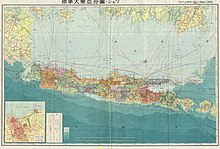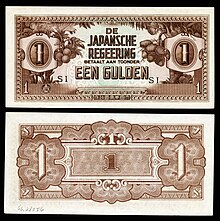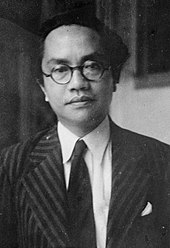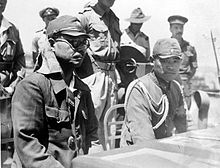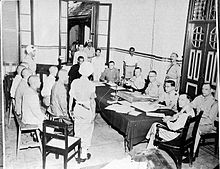Japanese occupation of the Dutch East Indies
The sentiment changed, however, as between 4 and 10 million Indonesians were recruited as forced labourers (romusha) on economic development and defense projects in Java.
[2] Four million people died in the Dutch East Indies as a result of famine and forced labour during the Japanese occupation, including 30,000 European civilian internee deaths.
[citation needed] The Japanese educated, trained and armed many young Indonesians and gave their nationalist leaders a political voice.
These ranged from small town barbers, photographic studios and salesmen, to large department stores and firms such as Suzuki and Mitsubishi becoming involved in the sugar trade.
[17] The Japanese population in Indonesia peaked in 1931 with 6,949 residents before starting a gradual decrease, largely as a result of economic tensions between Japan and the Netherlands Indies government.
[19] Japanese aggression in Manchuria and China in the late 1930s caused anxiety amongst the Chinese in Indonesia who set up funds to support the anti-Japanese effort.
[22] In the weeks leading up to the invasion, senior Dutch government officials went into exile, taking political prisoners, family, and personal staff to Australia.
[30] As famed Indonesian writer Pramoedya Ananta Toer noted: "With the arrival of the Japanese just about everyone was full of hope, except for those who had worked in the service of the Dutch.
[27] In addition to the 100,000 European (and some Chinese) civilians interned, 80,000 Dutch, British, Australian, and US Allied troops went to prisoner-of-war camps where the death rates were between 13 and 30 percent.
Indonesian co-operation allowed the Japanese military government to focus on securing the large archipelago's waterways and skies and using its islands as defense posts against any Allied attacks (which were assumed to most likely come from Australia).
The sōkan oversaw the Naval Civil Administration Office (Japanese: 民政府, romanized: minseifu) established in Makassar.
Many thousands of people were taken away from Indonesia as forced labourers (romusha) for Japanese military projects, including the Burma-Siam and Saketi-Bayah railways, and suffered or died as a result of ill-treatment and starvation.
In the National Revolution that followed, tens, even hundreds, of thousands, would die in fighting against the Japanese, Allied forces, and other Indonesians, before independence was achieved.
"[38][39] Other young women (and their families), faced with various pressures in the internment camps or in wartime society, agreed to offers of work, the nature of which was frequently not explicitly stated.
[60] Francis Stanley (Frank) Terry, an Australian sailor on a naval vessel participated in the repatriation of Indonesian Javanese comfort women from islands across Indonesia back to their home.
[68] On 28 August 1945 the British and Australians gave medical treatment to 300 Javanese and Malay male slaves of the Japanese who were malnourished and starving from forced labour.
[81] Eurasians, Indians, Chinese, Dutch, Menadonese, Bataks, Bugis, Dayaks, Javanese, Arabs and Malays were arrested and massacred in the Mandor affair.
In Sukmana, Singapurna, the Tasikmalaya regency, the conservative religious teacher Kiai Zainal Mustafa told his followers that in the month when Muhammad was born they would gain divine protection when he gave a sign.
[86] In the 1943–1944 Pontianak incidents (also known as the Mandor Affair), the Japanese orchestrated a mass arrest of Malay elites and Arabs, Chinese, Javanese, Manadonese, Dayaks, Bugis, Bataks, Minangkabau, Dutch, Indians, and Eurasians in Kalimantan, including all of the Malay Sultans, accused them of plotting to overthrow Japanese rule, and then massacred them.
[99] According to Jamie S. Davidson, this rebellion, during which many Dayaks and Japanese were killed, occurred from April through August 1945, and was called the "Majang Desa War".
Japanese troops armed with mortars and machine guns were attacked by sword-wielding Acehnese led by Tengku Abdul Djalil.
[104] In the initial stages of the occupation, the Japanese were completely opposed to independence because of possible disruption to the exploitation of the resources in the archipelago that were so important to the war effort.
[105] In November 1943, the Japanese held a Greater East Asia Conference in Tokyo attended by the notionally independent countries of the Co-Prosperity Sphere, including Thailand, the Philippines and Burma, but no Indonesian representatives were invited.
By way of compensation, pre-war independence figure Sukarno, Hatta and Hajar Dewantara were invited to Tokyo just after the conference, and were granted an audience with Emperor Hirohito and met Prime Minister Tojo.
A Central Advisory Board was established, headed by pre-war independence figure Sukarno, with Indonesians appointed as advisors.
With the war situation becoming increasingly dire, in March 1945 the Japanese announced the formation of an Investigating Committee for Preparatory Work for Independence (BPUPK), comprising members of the older political generation, including Sukarno and Hatta.
[108][109] On 29 April 1945, Lt. Gen. Kumakichi Harada, the commander of the 16th Army in Java established the Investigating Committee for Preparatory Work for Independence (Indonesian: Badan Penyelidik Usaha Persiapan Kemerdekaan (BPUPK); Japanese: 独立準備調査会, Dokuritsu Junbi Chōsakai), as the initial stage of the establishment of independence for the area under the control of the 16th Army.
[110] General Douglas MacArthur wanted to fight his way with Allied troops to liberate Java in 1944–45 but was ordered not to by the Joint Chiefs and President Franklin Roosevelt.
[112] The priorities for the UK occupation was to take the surrender of, and repatriate, Japanese forces, and also the Recovery of Allied Prisoners of War and Internees operation.
[115][116][117] The final stages of warfare were initiated in October 1945 when, in accordance with the terms of their surrender, the Japanese tried to re-establish the authority they relinquished to Indonesians in the towns and cities.
